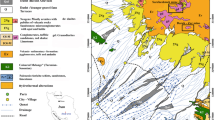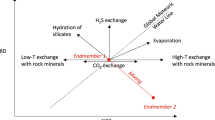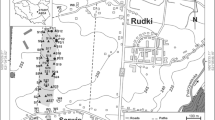Abstract
In application at the Zlatna gold mining area (Apuseni Mountains, Romania), the correlation of water isotopes and geochemical data were successfully used to assess the genetic relationships between surface running water, groundwater and mine water, as well as to evaluate the mining effects on the surrounding environment after the cessation of mining operations. The majority of mine water sources display pH values between 4 and 5, i.e. acid mine water. The mine water characterized by slightly higher pH values (~6) interacts with ophiolitic rocks which have high pH buffering capacity. The neutral mine water (pH ~ 7) does not come into direct contact with reactive minerals, either because it is discharged from an exploration adit or because of the complete leaching of pyrite and other sulphides in old abandoned mining works. The later also shows low levels of heavy metals concentrations. Calcium is the dominant cation in mine water and in the majority of surface running water and groundwater sources, indicating the same mechanisms of mineralization. All mine water sources are \(\text{SO}_{4}^{2 - }\) type and show very high \(\text{SO}_{4}^{2 - }\) concentrations (6539 mg/l mean value). Surface and groundwater sources are classified either as \(\text{SO}_{4}^{2 - }\) or as \(\text{HCO}_{3}^{ - }\) type water. Linear correlation between δD and δ18O values indicates that all water sources belong to the meteoric cycle. Low δD and δ18O values of mine water (δD < −70‰; δ18O < −10‰) suggest snow melt and high-altitude precipitations as the main source of recharge. The mine water is less affected by the seasonal variation of temperature. In most cases, the variations in isotopic composition are within narrow limits (less than 1‰ for both δD and δ18O), and this result suggests well-mixed underground systems. Elevated concentration of sulphates, Zn and Fe in mine waters are the main issues of concern. For the study area, no relevant contamination of springs or phreatic water by mine water was revealed. On the contrary, surface running water is contaminated by mine water, and the negative effects of acid mine drainage occur mainly in the summer months when the flow of the surface running water decreases.








Similar content being viewed by others
References
Appelo CAJ, Postma D (2004) Geochemistry, groundwater and pollution. CRC Press, Rotterdam
Atanacković N, Dragišić V, Stojković J et al (2013) Hydrochemical characteristics of mine waters from abandoned mining sites in Serbia and their impact on surface water quality. Environ Sci Pollut Res 20:7615–7626. doi:10.1007/s11356-013-1959-4
Banks D, Younger PL, Arnesen RT et al (1997) Mine-water chemistry: the good, the bad and the ugly. Environ Geol 32(3):157–174
Berza T, Constantinescu E, Vlad SN (1998) Upper Cretaceous magmatic series and associated mineralisation in the Carpathian-Balkan Orogen. Resour Geol 48:281–306
Blaga L, Blaga LM, Ciobotaru T (1975) The origin and evolution of some mineral water sources estimated from their deuterium content. Isotopenpraxis 11:297–301
Borcoş M, Roşu E, Andrei J et al (1981) Metalogenetic Geological map of Romania, scale 1:50 000, sheet Zlatna. Geological Institute of Romania, Bucharest
Clark ID, Fritz P (1997) Environmental isotopes in hydrogeology. Taylor & Francis, London
Cozma AI, Baciu CB, Papp D et al (2017) Isotopic composition of precipitation in western Transylvania (Romania) reflected by two local meteoric water lines. Carpathian J Earth Environ Sci 12:357–364
Craig H (1961) Isotopic variations in meteoric waters. Science 133:1702–1703. doi: 10.1126/science.133.3465.1702
Gat JR (1971) Comments on the stable isotope method in regional groundwater investigations. Water Resour Res 7:980–993. doi:10.1029/WR007i004p00980
Hazen JM, Williams MW, Stover B, Wireman M (2002) Characterisation of acid mine drainage using a combination of hydrometric, chemical and isotopic analyses, Mary Murphy mine, Colorado. Environ Geochem Health 24:1–22
Hounslow AW (1995) Water quality data—analysis and interpretation. CRC Press, Boca Raton
Ianovici V, Borcoş M, Bleahu M et al (1976) Geologia Munt̗ilor Apuseni. Editura Academiei R.S.R, Bucureşti
Kortelainen N, Karhu J (2004) Regional and seasonal trends in the oxygen and hydrogen isotope ratios of Finnish groundwaters: a key for mean annual precipitation. J Hydrol 285:143–157
Lottermoser BG (2007) Mine wastes: characterization, treatment, environmental impacts, 2nd edn. Springer, Berlin
Marescotti P, Carbone C, De Capitani L et al (2008) Mineralogical and geochemical characterisation of open-air tailing and waste-rock dumps from the Libiola Fe–Cu sulphide mine (Eastern Liguria, Italy). Environ Geol 53:1613–1626. doi:10.1007/s00254-007-0769-8
Milu V, Leroy JL, Peiffert C (2002) Water contamination downstream from a copper mine in the Apuseni Mountains, Romania. Environ Geol 42:773–782. doi:10.1007/s00254-002-0580-5
Morin KA, Hutt NM (1997) Environmental geochemistry of minesite drainage: practical theory and case studies. MDAG Publishing, Vancouver
Navarro Flores A, Martínez Sola F (2010) Evaluation of metal attenuation from mine tailings in SE Spain (Sierra Almagrera): a soil-leaching column study. Mine Water Environ 29:53–67. doi:10.1007/s10230-010-0099-z
Navarro A, Font X, Viladevall M (2015) Metal mobilization and zinc-rich circumneutral mine drainage from the abandoned mining area of osor (Girona, NE Spain). Mine Water Environ 34:329–342. doi:10.1007/s10230-015-0344-6
Nordstrom DK (2011) Hydrogeochemical processes governing the origin, transport and fate of major and trace elements from mine wastes and mineralized rock to surface waters. Appl Geochem 26:1777–1791. doi:10.1016/j.apgeochem.2011.06.002
Panichi C, Gonfiantini RR (1981) Stable isotope hydrology, Deuterium and Oxygen-18 in the water cycle. In: Gat JR, Gonfiantini RR (eds) IAEA, Technical Reports Series No. 210, pp 241–268
Papp DC (2000) Deuterium content and salinity of the present free waters from Rodna-Bârgău Mountains, East Carpathians, Romania: an assessment for their origin and underground dynamics. J Geochem Explor 69–70:429–433
Papp DC, Cociuba I (2011) Application of stable hydrogen isotope models to the evaluation of groundwater and geothermal water resources: case of the Pădurea Craiului limestone aquifer system. Geochem Explor Environ Anal 11:79–91
Papp DC, Cociuba I, Baciu C, Cozma, A. (2016) Goldschmidt Abstracts 2016 2430 (2016) Isotopes as tracer for groundwater—surface water—mine water interactions in post-mining environments: the case study of Zlatna mining area (Romania). In: Goldschmidt Abstracts, 2016 2430
Papp DC, Cociuba I, Baciu C, Cozma A (2017) Composition and origin of mine water at Zlatna gold mining area (Apuseni Mountains, Romania). Procedia Earth Planet Sci 17:37–40. doi:10.1016/j.proeps.2016.12.018
Payne BR (1981) Practical applications of stable isotopes to hydrological problems. In: Gat JR, Gonfiantini R (eds) Stable isotope hydrology, Deuterium and Oxygen-18 in the water cycle. IAEA, Technical Reports Series, No. 210. pp 303–334
Plumlee GS, Smith KS, Montour MR et al (1999) Geologic controls on the composition of natural waters and mine waters draining diverse mineral-deposit types. In: Filipek LH, Plumlee GS (eds) Reviews in economic geology, vol 6. Society of Economic Geologists, Littleton, pp 373–432
Ros̗u E, Udubașa G, Pécskay Z et al (2004) Timing of Miocene-Quaternary magmatism and metallogeny in the south Apuseni mountains, Romania. Rom J Miner Depos 81:33–38
Seghedi I, Maţenco L, Downes H et al (2011) Tectonic significance of changes in post-subduction Pliocene-Quaternary magmatism in the south east part of the Carpathian-Pannonian Region. Tectonophysics 502:146–157
Servida D, Comero S, Dal Santo M et al (2013) Waste rock dump investigation at Roşia Montană gold mine (Romania): a geostatistical approach. Environ Earth Sci 70:13–31. doi:10.1007/s12665-012-2100-6
Sima M, Zobrist J, Senila M et al (2008) Environmental pollution by mining activities: a case study in the Criş Alb Valley, Western Carpathians, Romania. In: Proceedings of the Swiss—Romanian research programme on environmental science & technology (ESTROM), pp 9–20
Vermeulen PD, Burger M, van Wyk A, Lukas E (2014) Using environmental isotopes in a coal mine and a gold mine to determine groundwater interaction. Mine Water Environ 33:15–23
Acknowledgements
The present contribution was funded by the Romanian National Authority for Scientific Research, CCCDI—UEFISCDI, project 3-004/2014 SUSMIN. Marian Munteanu and Raluca Maftei are thanked for effective coordination and support during the implementation of the project. Larkins Clayton is thanked for collaboration and for providing language help. Many thanks are addressed to two anonymous reviewers and the journal Editor who helped to improve the quality of an early draft of the manuscript with important remarks and valuable suggestions.
Author information
Authors and Affiliations
Corresponding author
Electronic supplementary material
Below is the link to the electronic supplementary material.
Rights and permissions
About this article
Cite this article
Papp, D.C., Cociuba, I., Baciu, C. et al. Origin and Geochemistry of Mine Water and its Impact on the Groundwater and Surface Running Water in Post-mining Environments: Zlatna Gold Mining Area (Romania). Aquat Geochem 23, 247–270 (2017). https://doi.org/10.1007/s10498-017-9321-y
Received:
Accepted:
Published:
Issue Date:
DOI: https://doi.org/10.1007/s10498-017-9321-y




